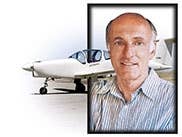
Japan has been a marginal, but potentially formidable, presence in American aviation since the late 1960s.
Fuji Heavy Industries, which had previously manufactured both two- and four-seat versions of the Beech T-34 Mentor for domestic military forces, produced almost 300 of the FA200 Aero Subaru, which looked the way a 172 would if you replaced its high wing with the low one of a Beech Musketeer. Mitsubishi followed suit with the technically innovative-maybe too innovative-MU-2 turboprop and subsequently the Diamond business jet, the latter marketed in the United States by Beech as the Hawker 400 and adopted by the U.S. Air Force as a trainer.
Other giants loom offshore. Toyota certified an aviation version of the 250-hp Lexus V-8, which it has made no effort to put on the market, and also built and tested, at Mojave, California, a prototype of a composite airplane of the same class as the Fuji Aero Subaru, but better-looking. Honda has developed a small (1,780-lb thrust) jet engine in a commercial partnership with General Electric, and a prototype business jet in which to demonstrate it. Toyota has done nothing to publicize its aviation ventures, which include an aeronautical project development staff in Los Angeles; Honda, on the other hand, while remaining noncommittal on production plans for the jet, has made no secret of its existence, displaying it in promotional videos and at Oshkosh this year.
The configuration of small business jets, like that of mid-size sedans, is so universally agreed upon that competing models can be told apart only by fanatics and teenage boys. Unlike Honda cars, however, which cultivate an appearance of bland anonymity, the Honda jet makes a conscious effort to look different.
Its two recognition features are a curiously bulbous nose resembling those on some transonic fighters and said to be conducive to laminar flow, and the mounting of the two engines atop vertical pylons sprouting from the wings. It's the overwing engines that get most of the press.
The placement of engines with respect to wings has been a subject of much study for the past 60 or 70 years. It's a complex topic that involves the interplay of the flow fields of the wing and the propeller or jet inlet or efflux, and sometimes other factors as well, like transonic shock patterns and ingestion by the engines of ice or slush shed from the wings. Since engines are usually quite large, they disrupt lift and alter stalling characteristics; stalling of the wing, on the other hand, may disrupt flow into a jet engine placed above or behind it. The preferred placement for jet engines, therefore, has been either below and ahead of the wings or above and farther behind them. As a general rule, the closer to the wing the engine is the more troublesome its aerodynamics are likely to be. Boeing made much of its success-credited to computer simulations of airflow- in cramming big fat fan engines under the wings of the 737, whose ground clearance was originally intended to accommodate only slender turbojets.
Honda's is not the first design to place jet engines atop the wings. The VFW-Fokker 614, a 44-seat feeder liner that made its maiden flight in 1971, carried its two 7,280-lb Rolls-Royce M45 fan engines atop heavily cambered pylons that somewhat resemble the Honda's. The intent, in that case, was to protect the engines from contamination on unprepared strips, although other benefits were claimed, such as the greater efficiency of one-piece flaps and some noise reduction due to the wing being between the engines and the listeners on the ground.
It is usually the case, when a novel design feature has been selected for one reason or another, that company flacks dream up three or four other supposed advantages, in somewhat the way that an unskillful liar, fearful that one account of his activities is not enough, piles on a few others for good measure. The choice before designers, in this case, was between the 737's underwing mounting and the DC-9's fuselage-mounted aft engines. The latter arrangement actually dated all the way back to the Sud Aviation Caravelle. For a DC-3 replacement, the underwing location would not have seemed attractive, in part because of the junk-ingestion problem, and in part because it raised the fuselage to an inconvenient height for loading. There may also have been a desire to avoid a T- tail with its attendant risk of deep-stall issues. The reduction in ground noise footprint sounds like an afterthought; it can hardly have outweighed the presumed increase in cabin noise and the loss of view through several cabin windows. Aft engines would also have allowed a continuous flap-no great benefit there.
A number of claims have likewise been made about the Honda, including a reduction in wing bending stress and hence structure weight. Maybe; but the pylons are larger than those on airplanes with aft-mounted engines, and probably cancel that hypothetical weight gain. Another benefit is said to be an increase in cabin length, but no mention is made of loss of visibility for the passengers. The main claim made for the Honda Jet, actually, is unusually low fuel consumption. Is it due to the engine placement? Not likely; more probably, it's the engines themselves.
My guess is that the overwing arrangement came from a desire for something unusual that people would talk about. And if that's what they wanted, they got it.

Sign-up for newsletters & special offers!
Get the latest FLYING stories & special offers delivered directly to your inbox






